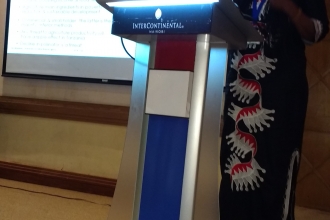
Insect pollination centre stage at African conference
Healthy forests in sub-Saharan Africa are an important source of wild pollinators, and thus support agricultural productivity and food security in the region, a conference in the Kenyan capital…

Healthy forests in sub-Saharan Africa are an important source of wild pollinators, and thus support agricultural productivity and food security in the region, a conference in the Kenyan capital…
This paper seeks to examine how communities value a variety of dryland environmental amenities provided by the Kgalagadi Transfontier Park where there is an interest in limiting their access, both in order to protect the environment and in order to make it more attractive for tourists. This is done using a choice experiment, which targeted households in the Kgalagadi area.
This paper demonstrates the importance of wildlife in the portfolio of environmental income in the livelihoods of
poor rural communities living adjacent to a national park. The results show that wealthier households use more
wildlife resources in total than do relatively poor households. However, poorer households derive greater proportional
benefit than wealthier households from the use of wildlife resources. Excluding wildlife understates
the relative contribution of environmental resources while at the same time overstating the relative contribution
Sharing conservation revenue with communities surrounding parks could demonstrate the link
between ecotourism and local communities’ economic development, promote a positive view of
land restitution involving parks, help address skewed distribution of income in the vicinity of parks
and act as an incentive for local communities to participate in conservation even more. This article
estimates the visitation demand function for Kgalagadi Transfrontier Park (KTP) in order to
This article examines how basic socioeconomic and political factors are associated with higher levels of cooperation to garner a local community's shared green reputation. We analyze panel data on participation efforts in a collective voluntary environmental program, the Ecological Blue Flag Program, by the entire population of beach communities in Costa Rica between 2001 and 2009.
Most hydrological studies do not account for the socio-economic influences on eco-hydrological processes. However, socio-economic developments often change the water balance substantially and are highly relevant in understanding changes in hydrological responses. In this study a multi-disciplinary approach was used to study the cascading impacts of socio-economic drivers of land use and land cover (LULC) changes on the eco-hydrological regime of the Lake Naivasha Basin. The basin has recently experienced substantial LULC changes exacerbated by socio-economic drivers.
This study discusses the effects of water abstractions from two alternative sources on the available water volume around Lake Naivasha, Kenya: the lake itself and a connected aquifer. An estimation of the water abstraction pattern for the period 1999–2010 is made and its effect on the available water volume in Lake Naivasha and its connected aquifer is evaluated using a simple water balance modeling approach.
Remotely-sensed data can be used to overcome deficiencies in data availability in poorly monitored regions. Reliable estimates of human population densities at different spatial levels are often lacking in developing countries. This study explores the applicability of a geographically-weighted regression (GWR) model for estimating population densities in rural Africa using land use/cover data that have been derived from remote-sensing while accounting for spatial non-stationarity.
Interventions in payment for ecosystem services (PES) programs can involve both collective and individual actions. This study explores the potential for the development of payment for water related ecosystem services (PWES) program in the Lake Naivasha basin, Kenya. Using a choice experiment approach, the willingness to accept compensation is estimated for three water-related ecosystem services (WES) attributes: one collective attribute (reforestation) and two individual attributes (environment-friendly agricultural practices and restoration of riparian land).